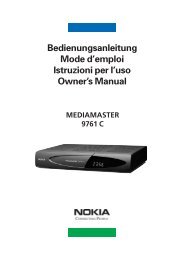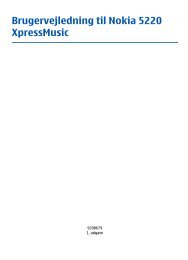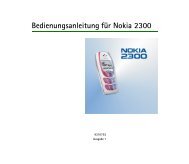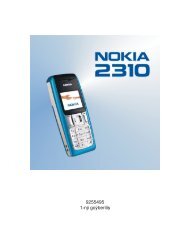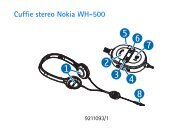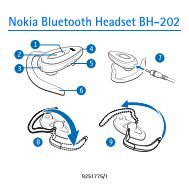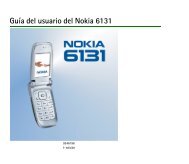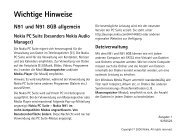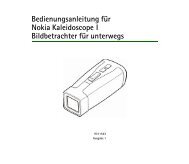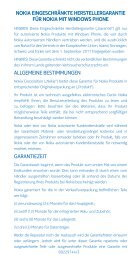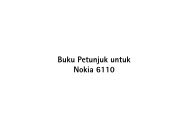Establishing a WLAN connection - Nokia
Establishing a WLAN connection - Nokia
Establishing a WLAN connection - Nokia
Create successful ePaper yourself
Turn your PDF publications into a flip-book with our unique Google optimized e-Paper software.
9245749<br />
Issue 1 EN<br />
<strong>Nokia</strong> and <strong>Nokia</strong> Connecting People are registered trademarks of <strong>Nokia</strong> Corporation
<strong>Nokia</strong> 9500 Communicator<br />
Using <strong>WLAN</strong><br />
Legal Notice<br />
Copyright © <strong>Nokia</strong> 2005. All rights reserved.<br />
Reproduction, transfer, distribution or storage of part or all of the contents in this<br />
document in any form without the prior written permission of <strong>Nokia</strong> is prohibited.<br />
<strong>Nokia</strong> and <strong>Nokia</strong> Connecting People are registered trademarks of <strong>Nokia</strong> Corporation.<br />
Other product and company names mentioned herein may be trademarks or trade<br />
names of their respective owners.<br />
<strong>Nokia</strong> operates a policy of continuous development. <strong>Nokia</strong> reserves the right to make<br />
changes and improvements to any of the products described in this document<br />
without prior notice.<br />
Copyright © 2005 <strong>Nokia</strong>. All rights reserved.<br />
Under no circumstances shall <strong>Nokia</strong> be responsible for any loss of data or income or<br />
any special, incidental, consequential or indirect damages howsoever caused.<br />
The contents of this document are provided "as is". Except as required by applicable<br />
law, no warranties of any kind, either express or implied, including, but not limited<br />
to, the implied warranties of merchantability and fitness for a particular purpose, are<br />
made in relation to the accuracy, reliability or contents of this document. <strong>Nokia</strong><br />
reserves the right to revise this document or withdraw it at any time without prior<br />
notice.
Introduction<br />
The purpose of this document is to guide you in using<br />
wireless LAN (<strong>WLAN</strong>) <strong>connection</strong>s with your <strong>Nokia</strong> 9500<br />
Communicator. Typical situations in which you might use<br />
<strong>WLAN</strong> with <strong>Nokia</strong> 9500 Communicator include, but are not<br />
limited to, downloading e-mail with attachments,<br />
browsing the web and downloading files, connecting to<br />
company network, connecting to a <strong>WLAN</strong>-capable laptop<br />
computer, and sending a document to a <strong>WLAN</strong>-connected<br />
printer. <strong>WLAN</strong> <strong>connection</strong>s can be used both in public<br />
situations, such as when waiting at an airport or staying at<br />
a hotel, and in private wireless networks at your office or<br />
home.<br />
<strong>Nokia</strong> 9500 Communicator supports the following <strong>WLAN</strong><br />
features:<br />
• IEEE 802.11b <strong>WLAN</strong> standard<br />
Wi-Fi Protected Access 1.0 (WPA)<br />
232-bit WEP keys<br />
For interoperability with older <strong>WLAN</strong> networks, <strong>Nokia</strong><br />
9500 Communicator also supports the legacy static<br />
WEP security and dynamic WEP security<br />
<strong>Nokia</strong> 9500 Communicator does not support the IEEE<br />
802.11a and IEEE 802.11g <strong>WLAN</strong> standards.<br />
Note: The typical transmission range of <strong>WLAN</strong><br />
<strong>connection</strong>s is limited from 30 meters in<br />
indoor spaces to 100 meters in open spaces.<br />
The range of wireless devices can be affected<br />
by metal surfaces, solid high-density materials<br />
and obstacles in the signal path.<br />
Copyright © 2005 <strong>Nokia</strong>. All rights reserved.<br />
Introduction<br />
3
Defining <strong>WLAN</strong> <strong>connection</strong> settings<br />
4<br />
Defining <strong>WLAN</strong><br />
<strong>connection</strong> settings<br />
This chapter discusses the <strong>WLAN</strong> settings in <strong>Nokia</strong> 9500<br />
Communicator. Special focus is on the selection of the<br />
<strong>WLAN</strong> security mode.<br />
Different connectivity settings, including GPRS, <strong>WLAN</strong><br />
and other technologies, are organized in so called Internet<br />
Access Points (IAPs) in your device. For <strong>WLAN</strong> access point<br />
usage, a <strong>WLAN</strong> IAP can be created. The advantage of using<br />
<strong>WLAN</strong> access point is that you have more control<br />
(particularly regarding security) over network traffic<br />
because it passes through the access point, and that you<br />
can use any resources in the wired network that the<br />
<strong>WLAN</strong> access point is connected to. The most important<br />
settings in the <strong>WLAN</strong> IAP include the network name<br />
(SSID), the <strong>WLAN</strong> security mode, and the security mode<br />
specific security settings.<br />
It is not always necessary to pre-configure the IAP<br />
settings, as the user can select the Easy <strong>WLAN</strong> Internet<br />
Access Point. The Easy <strong>WLAN</strong> IAP allows the user to<br />
connect to newly discovered <strong>WLAN</strong> networks for which<br />
there is no pre-configured IAP. In <strong>WLAN</strong> access point<br />
usage, the Easy <strong>WLAN</strong> IAP can be used for <strong>connection</strong>s to<br />
open networks (security mode "None") that use HTTP<br />
based logon.<br />
Copyright © 2005 <strong>Nokia</strong>. All rights reserved.<br />
It is also possible for <strong>WLAN</strong> devices to communicate<br />
directly with each other without any <strong>WLAN</strong> access points.<br />
This is done via ad hoc networks, which are established by<br />
a single user and others can then join in. Ad hoc<br />
<strong>connection</strong>s are easy to set up, but they are limited to<br />
devices within the wireless transmission range. You can<br />
use ad hoc <strong>WLAN</strong> <strong>connection</strong>s to print a document in your<br />
device to a compatible printer, for example.<br />
Creating a <strong>WLAN</strong> Internet Access<br />
Point for a <strong>WLAN</strong> access point<br />
To create a new Internet Access Point, select Desk→<br />
Tools→ Control Panel→ Connections→ Internet setup.<br />
When the list of existing IAPs is shown, press New to<br />
create a new one. If there are existing IAPs, the setup asks
you if you want to use of of them as a basis for the new<br />
IAP.<br />
1 Define the following settings:<br />
• Internet settings name — Type any name you want for<br />
the IAP; “Operator X <strong>WLAN</strong> service”, for example.<br />
Network ID — Select the network ID for the<br />
<strong>connection</strong>. In most cases this can be Internet (the<br />
other option is Default GPRS network, which you<br />
probably already have settings for).<br />
Internet settings type — Select Wireless LAN.<br />
Press Next to proceed.<br />
2 Define the following settings:<br />
Network mode — Select Infrastructure to be able to<br />
connect to <strong>WLAN</strong> networks through a <strong>WLAN</strong> access<br />
point. The other option is Ad hoc, which is discussed<br />
later in this chapter.<br />
Network name — Enter the exact (case sensitive)<br />
network name (SSID) of the <strong>WLAN</strong> network. The<br />
name must be exactly the same as in your Wi-Fi<br />
router. If you do not enter the SSID here, you are not<br />
able to connect to networks that use a hidden SSID.<br />
Press Next to proceed.<br />
3 Select the <strong>WLAN</strong> security mode. <strong>Nokia</strong> 9500<br />
Communicator supports the following <strong>WLAN</strong> security<br />
modes:<br />
None — This security mode is commonly used with<br />
HTTP based logon. User authentication is performed<br />
at a higher layer using a HTML login page.<br />
WEP — This security mode is supported for<br />
compatibility with IEEE 802.11 Wired Equivalent<br />
Privacy (WEP) networks. Pre-configured static WEP<br />
keys are required for this mode. There are two<br />
notations in use in the <strong>WLAN</strong> industry for the WEP<br />
key length representation, which sometimes makes<br />
things a bit confusing. The reason is that WEP key<br />
has a 24 bit common part and some vendors count<br />
this as being part of the key length, while some<br />
vendors do not. <strong>Nokia</strong> uses the latter notation. Both<br />
notations are equivalent at <strong>WLAN</strong> protocol level<br />
and fully interoperable. <strong>Nokia</strong> 9500 Communicator<br />
supports 40 (64) bit, 104 (128) and 232 (256) bit<br />
WEP key lengths.<br />
Copyright © 2005 <strong>Nokia</strong>. All rights reserved.<br />
Defining <strong>WLAN</strong> <strong>connection</strong> settings<br />
5
Defining <strong>WLAN</strong> <strong>connection</strong> settings<br />
6<br />
Note: The WEP mode provides a lower<br />
level of security than the Wi-Fi<br />
Protected Access (WPA) mode. If you<br />
use the WEP mode, you should change<br />
the key regularly.<br />
When this security mode is selected and you press<br />
Next, the following dialog will be shown. Configure<br />
the WEP key by selecting its number, length and<br />
type and then entering the key.<br />
Note: A WEP key can be entered in<br />
hexadecimal (HEX) or text (ASCII)<br />
format. It is important that the same<br />
notation is used both in the access point<br />
and the <strong>Nokia</strong> 9500 Communicator. A<br />
104 bit WEP key is the same as a 128 bit<br />
WEP key, and you should enter 26<br />
characters if you are using the HEX<br />
format, or 13 characters if you are using<br />
the ASCII format. Similarly, a 40 (64) bit<br />
WEP key requires 10 (HEX) or 5 (ASCII)<br />
characters, and a 232 (256) bit key<br />
requires 58 (HEX) or 29 (ASCII)<br />
characters.<br />
Copyright © 2005 <strong>Nokia</strong>. All rights reserved.<br />
802.1x — This security mode is provided in order to<br />
support the legacy Dynamic WEP system, and to<br />
support networks that are migrating from Dynamic<br />
WEP to Wi-Fi Protected Access (WPA). In this mode,<br />
<strong>Nokia</strong> 9500 Communicator is able to join both<br />
dynamic WEP and WPA networks. Dynamic WEP<br />
refers to the fact that WEP keys are not static or preconfigured,<br />
but they are dynamically generated as<br />
part of the Extensible Authentication Protocol (EAP)<br />
authentication procedure. If <strong>WLAN</strong> access points<br />
support WPA, then it is recommended to use the<br />
WPA security mode instead of this mode.<br />
WPA — The Wi-Fi Protected Access (WPA) security<br />
mode provides the highest level of security among<br />
the <strong>WLAN</strong> security modes of <strong>Nokia</strong> 9500<br />
Communicator. As required by the Wi-Fi<br />
specifications, WEP ciphering is not allowed in this<br />
mode, so Temporal Key Integrity Protection (TKIP) is<br />
used as the ciphering method.<br />
When this security mode is selected and you press<br />
Next, the following dialog will be shown. Select EAP<br />
in order to use Extensible Authentication Protocol<br />
(EAP) based logon, or select Pre-shared key to use a<br />
master password, which you must then enter.
A WPA pre-shared key needs to be at least 8<br />
characters long..<br />
Press Next to proceed. If you do not need to configure<br />
any advanced settings, press Finish to save the settings<br />
of your new IAP. Otherwise, press Advanced.<br />
Note: If you selected the 802.1x or the<br />
WPA/EAP security mode, you have to access<br />
the advanced settings to configure EAP<br />
settings.<br />
4 In the advanced settings, press Menu to change to the<br />
802.1x page (in 802.1x mode) or WPA page (in WPA<br />
mode), and make sure that the WPA mode is set to EAP,<br />
as it should by default. This means that EAP based<br />
logon will be used.<br />
Press Menu again to change to the EAP page and<br />
configure the EAP settings. Select the EAP methods<br />
that are allowed in this mode by moving up and down<br />
in the list and pressing Disable or Enable. Typically, the<br />
user uses only one EAP method, so in most cases only<br />
one EAP method should be enabled in this dialog.<br />
5 In the advanced settings, press Menu to change to the<br />
IP configuration page and set the IP address and<br />
parameters, if necessary. In public wireless LAN<br />
networks DHCP is typically used, so the default value<br />
Yes for Auto retrieve IP should be used there. For the<br />
IPv6 DNS mode, you can select one of three<br />
alternatives: DHCP, Manual or Well known. If you select<br />
Manual, you need to type the IP addresses of the<br />
primary and secondary DNS servers.<br />
6 In the advanced settings, press Menu to change to the<br />
Proxies page and configure the HTTP and HTTPS proxy<br />
settings, if necessary. If a web proxy needs to be used,<br />
select the protocol (HTTP or HTTPS), set User proxy<br />
server to Yes, type the IP address or domain name of<br />
the Proxy Server, type the Port Number (for example<br />
8000 or 8080). You can use the No proxy for field to<br />
define the domains for which the HTTP or HTTPS proxy<br />
is not needed.<br />
7 Press Done and press Finish to save the settings of<br />
your new IAP.<br />
Copyright © 2005 <strong>Nokia</strong>. All rights reserved.<br />
Defining <strong>WLAN</strong> <strong>connection</strong> settings<br />
7
Defining <strong>WLAN</strong> <strong>connection</strong> settings<br />
8<br />
Creating a <strong>WLAN</strong> Internet Access<br />
Point for an ad hoc network<br />
To create a new Internet Access Point, select Desk→<br />
Tools→ Control Panel→ Connections→ Internet setup.<br />
When the list of existing IAPs is shown, press New to<br />
create a new one. If there are existing IAPs, the setup asks<br />
you if you want to use of of them as a basis for the new<br />
IAP.<br />
1 Define the following settings:<br />
Internet settings name — Type any descriptive name<br />
you want for the IAP; “Office ad hoc <strong>connection</strong>”,<br />
for example.<br />
Network ID — Select Internet as the network ID for<br />
the <strong>connection</strong>.<br />
Copyright © 2005 <strong>Nokia</strong>. All rights reserved.<br />
Internet settings type — Select Wireless LAN.<br />
Press Next to proceed.<br />
2 Define the following settings:<br />
Network mode — Select Ad hoc.<br />
Network name — Give the network a name.<br />
Press Next to proceed.<br />
3 Select the <strong>WLAN</strong> security mode. <strong>Nokia</strong> 9500<br />
Communicator supports the following <strong>WLAN</strong> security<br />
modes for ad hoc <strong>connection</strong>s:<br />
None<br />
WEP — This security mode is supported for<br />
compatibility with IEEE 802.11 Wired Equivalent<br />
Privacy (WEP) networks. Pre-configured static WEP<br />
keys are required for this mode. There are two<br />
notations in use in the <strong>WLAN</strong> industry for the WEP<br />
key length representation, which sometimes makes
things a bit confusing. The reason is that WEP key<br />
has a 24 bit common part and some vendors count<br />
this as being part of the key length, while some<br />
vendors do not. <strong>Nokia</strong> uses the latter notation. Both<br />
notations are equivalent at <strong>WLAN</strong> protocol level and<br />
fully interoperable. <strong>Nokia</strong> 9500 Communicator<br />
supports 40 (64) bit, 104 (128) and 232 (256) bit<br />
WEP key lengths.<br />
Note: The WEP mode provides a lower<br />
level of security than the Wi-Fi Protected<br />
Access (WPA) mode. If you use the WEP<br />
mode, you should change the key<br />
regularly.<br />
When this security mode is selected and you press<br />
Next, the following dialog will be shown. Configure<br />
the WEP key by selecting its number, length and type<br />
and then entering the key.<br />
Note: A WEP key can be entered in<br />
hexadecimal (HEX) or text (ASCII)<br />
format. It is important that the same<br />
notation is used both in the access point<br />
and the <strong>Nokia</strong> 9500 Communicator. A<br />
104 bit WEP key is the same as a 128 bit<br />
WEP key, and you should enter 26<br />
characters if you are using the HEX<br />
format, or 13 characters if you are using<br />
the ASCII format. Similarly, a 40 (64) bit<br />
WEP key requires 10 (HEX) or 5 (ASCII)<br />
characters, and a 232 (256) bit key<br />
requires 58 (HEX) or 29 (ASCII)<br />
characters.<br />
Press Next to proceed. If you do not need to configure<br />
any advanced settings, press Finish to save the<br />
settings of your ad hoc IAP.<br />
4 If you do need to configure advanced settings, press<br />
Advanced. On the IP configuration page, set the IP<br />
address and parameters, if necessary. In public<br />
wireless LAN networks DHCP is typically used, so the<br />
default value Yes for Auto retrieve IP should be used<br />
there. For the IPv6 DNS mode, you can select one of<br />
three alternatives: DHCP, Manual or Well known. If you<br />
select Manual, you need to type the IP addresses of the<br />
primary and secondary DNS servers.<br />
5 Press Menu to change to the Proxies page and<br />
configure the HTTP and HTTPS proxy settings, if<br />
necessary. If a web proxy needs to be used, select the<br />
protocol (HTTP or HTTPS), set User proxy server to Yes,<br />
Copyright © 2005 <strong>Nokia</strong>. All rights reserved.<br />
Defining <strong>WLAN</strong> <strong>connection</strong> settings<br />
9
Defining <strong>WLAN</strong> <strong>connection</strong> settings<br />
type the IP address or domain name of the Proxy<br />
Server, type the Port Number (for example 8000 or<br />
8080). You can use the No proxy for field to define the<br />
domains for which the HTTP or HTTPS proxy is not<br />
needed.<br />
6 Press Done and press Finish to save the settings of<br />
your ad hoc IAP.<br />
Defining general <strong>WLAN</strong> settings<br />
To access the general settings, select Desk→ Tools→<br />
Control Panel→ Connections→ Wireless LAN.<br />
1 Press Menu to access the Settings page, where you can<br />
define the Background scan interval. If background<br />
scanning is enabled, the device will detect the<br />
availability of <strong>WLAN</strong> automatically. The availability of<br />
a <strong>WLAN</strong> network will be indicated in the user interface<br />
with a small "W" icon. If background scanning is<br />
disabled, then <strong>WLAN</strong> networks will only be scanned for<br />
when an application is establishing a <strong>connection</strong> to<br />
the Internet.<br />
10 Copyright © 2005 <strong>Nokia</strong>. All rights reserved.<br />
Change the Background scan interval to the desired<br />
value (Never, 1 minutes, 2 minutes, 5 minutes, 10<br />
minutes). Selecting Never reduces battery consumption.<br />
2 Next, select whether <strong>WLAN</strong> power saving is enabled or<br />
disabled. There are differences in the way <strong>WLAN</strong> access<br />
points implement <strong>WLAN</strong> power saving, which may lead<br />
to interoperability problems with your device when<br />
<strong>WLAN</strong> power saving is used. Disabling <strong>WLAN</strong> power<br />
saving increases power consumption when <strong>WLAN</strong><br />
<strong>connection</strong>s are used.<br />
3 Press Done to save the settings.
<strong>Establishing</strong> a <strong>WLAN</strong><br />
<strong>connection</strong><br />
This chapter describes how you can establish a <strong>WLAN</strong><br />
<strong>connection</strong>. It uses a Web browser <strong>connection</strong> via the Easy<br />
<strong>WLAN</strong> IAP, which comes with the device, as an example,<br />
but other kinds of <strong>WLAN</strong> <strong>connection</strong>s, such as an ad hoc<br />
<strong>connection</strong> to your printer, work the same way.<br />
To establish a <strong>WLAN</strong> <strong>connection</strong>:<br />
1 Make sure you have a valid user name and password for<br />
the network.<br />
2 Switch on your <strong>Nokia</strong> 9500 Communicator.<br />
3 Press Web, and select Open Web address.<br />
4 Enter the URL of the Web page that you want to visit,<br />
and press Go to.<br />
5 In the Network <strong>connection</strong> list, select Easy <strong>WLAN</strong>, and<br />
press Connect.<br />
6 In the <strong>WLAN</strong> selection list, select the <strong>WLAN</strong> network,<br />
and press Connect.<br />
7 When your browser is redirected to the authentication<br />
page, enter your user name and password, and press<br />
OK.<br />
You can now use the <strong>connection</strong> just like any other<br />
<strong>connection</strong>. If you experience problems with the <strong>WLAN</strong><br />
<strong>connection</strong>, make sure that you are within the range of<br />
the access point.<br />
8 When you are finished, press Exit to close the<br />
<strong>connection</strong> and the browser.<br />
To close the <strong>connection</strong>, but leave the browser open,<br />
press Menu, and select File→ Disconnect.<br />
Copyright © 2005 <strong>Nokia</strong>. All rights reserved.<br />
<strong>Establishing</strong> a <strong>WLAN</strong> <strong>connection</strong><br />
11
Viewing the status of a <strong>WLAN</strong> <strong>connection</strong><br />
Viewing the status of a<br />
<strong>WLAN</strong> <strong>connection</strong><br />
To view the status of your <strong>WLAN</strong> <strong>connection</strong>, select<br />
Desk→ Tools→ Control Panel→ Connections→<br />
Wireless LAN.<br />
1 On the Status page you can see the <strong>connection</strong> status,<br />
network name, <strong>connection</strong> security and <strong>connection</strong><br />
quality of the currently open <strong>WLAN</strong> <strong>connection</strong>.<br />
2 Press Menu to change to the Networks page. In the<br />
Display field, select the network item you want, and<br />
press View details to view the following information:<br />
Networks — Select this to view all <strong>WLAN</strong> networks<br />
that can be accessed and their signal strength.<br />
12 Copyright © 2005 <strong>Nokia</strong>. All rights reserved.<br />
Access points — Select this to view the wireless LAN<br />
access points that are currently in range and<br />
available, and the radio frequency channel they are<br />
using.<br />
Ad hoc networks — Select this to view the available<br />
ad hoc networks.<br />
3 Press Menu to change to the Security page. Select an<br />
installed EAP security plug-in and press View details<br />
to view its name, release date, version and<br />
manufacturer.
<strong>WLAN</strong> troubleshooting<br />
Some common problems that may occur when using<br />
<strong>WLAN</strong> are discussed in this section.<br />
Wrong Bluetooth settings: if you cannot browse the<br />
Web even though the <strong>WLAN</strong> <strong>connection</strong> is working,<br />
select Desk→ Tools→ Control Panel→<br />
Connections→ Wireless LAN→ Settings and disallow<br />
Simultaneous Bluetooth usage, if it is allowed. Then you<br />
must remove the battery, reinsert it and switch on the<br />
device before browsing the Web again. This also turns<br />
off <strong>WLAN</strong> power saving in your device.<br />
The <strong>WLAN</strong> icon sometimes appears different: the<br />
<strong>WLAN</strong> network icon “W” in the upper left corner of the<br />
screen has the following implications for<br />
troubleshooting:<br />
1 If the icon is not displayed at all, a <strong>WLAN</strong> <strong>connection</strong><br />
has not been successfully established.<br />
2 If the “W” icon is displayed and surrounded by a box<br />
graphic (see the image above) or a lock graphic (see<br />
the image below) but data cannot be transferred, the<br />
<strong>WLAN</strong> <strong>connection</strong> is working normally and the<br />
problem probably lies with TCP/IP.<br />
3 If background scanning is turned on and the “W”<br />
icon is displayed without any border graphics (see<br />
the image below), it means that a <strong>WLAN</strong> network is<br />
available (that is, there is network coverage). It does<br />
not indicate that a <strong>WLAN</strong> <strong>connection</strong> is active and<br />
can be used to transfer data.<br />
Wrong IP address: if the “W” icon is displayed and<br />
surrounded by a box or lock graphic but data cannot<br />
be transferred, the IP address may be defined<br />
incorrectly. To check the IP address of your <strong>WLAN</strong><br />
<strong>connection</strong>, select Desk→ Tools→ Conn. manager→<br />
Connections. Then select the open <strong>connection</strong>, press the Menu key and select select Tools→ IP address.<br />
Copyright © 2005 <strong>Nokia</strong>. All rights reserved.<br />
<strong>WLAN</strong> troubleshooting<br />
13
<strong>WLAN</strong> troubleshooting<br />
If DHCP is being used but it failed to retrieve the<br />
address, then an IP address starting with 169.254.x.x<br />
is shown. Sometimes it might take a while (up to 2<br />
minutes) for <strong>Nokia</strong> 9500 Communicator to receive IP<br />
settings from the server.<br />
If the IP addresses still appear incorrect, you can try<br />
the following two solutions:<br />
1 Disable <strong>WLAN</strong> power saving. To access the setting,<br />
select Desk→ Tools→ Control Panel→<br />
Connections→ Wireless LAN.<br />
2 Try using manually configured IP settings instead of<br />
DHCP. Notice that this requires that you have<br />
acquired the appropriate IP settings for the<br />
particular network. You should request them from<br />
the network administrator.<br />
Wrong proxy settings: if you cannot browse the Web<br />
even though the <strong>WLAN</strong> <strong>connection</strong> is working and the<br />
IP settings seem to be correct, check that the HTTP/<br />
HTTPS proxy settings are defined correctly in the<br />
Internet Access Point settings.<br />
Problems with the WEP security mode: if you<br />
encounter these, check that the WEP keys have been<br />
entered in the correct format (ASCII vs. HEX) and have<br />
the right number of characters. ASCII WEP keys are<br />
also case sensitive; check that you have not confused<br />
any upper or lower case letters in the key.<br />
Incorrect WEP keys may cause a situation where <strong>Nokia</strong><br />
9500 Communicator is able to associate with a <strong>WLAN</strong><br />
network (the “W” icon with a box graphic is visible)<br />
but no data can be transferred.<br />
14 Copyright © 2005 <strong>Nokia</strong>. All rights reserved.<br />
Also remember to check that the WEP authentication<br />
mode is correct. In the access point it may be called, for<br />
example, “WEP authentication”, “shared-key<br />
authentication” or “Wi-Fi security mode”.<br />
Poor signal quality: to check the signal quality of your<br />
<strong>WLAN</strong> <strong>connection</strong>, select Desk→ Tools→ Control<br />
Panel→ Connections→ Wireless LAN→ Networks.<br />
If the signal quality is weak or even moderate, you may<br />
encounter <strong>connection</strong> problems. Try again nearer the<br />
access point.<br />
Wrong security mode: if the “W” icon is displayed but<br />
not surrounded by a box or lock graphic, the configured<br />
security mode may not be the right mode. To check the<br />
security mode that the network uses, select Desk→<br />
Tools→ Control Panel→ Connections→ Wireless<br />
LAN→ Networks. Select the network and press<br />
Details.<br />
Problems with the WPA or 802.1x security mode: if<br />
you encounter these, check the following:<br />
1 Check that the WPA mode is the right one (preshared<br />
key or EAP).<br />
2 Check the pre-shared key.<br />
3 Check that all EAP types that are not needed are<br />
disabled.
4 Check that EAP type settings are correct (passwords,<br />
user names, certificates, etc.).<br />
Problems with access point configuration: if you<br />
encounter these, check the following:<br />
1 Many <strong>WLAN</strong> access points contain proprietary<br />
“Turbo” mode’s claiming to enhance data rates.<br />
These functionalities should be disabled from the IAP<br />
if there is any reason to believe that they are causing<br />
problems to legacy <strong>WLAN</strong> terminals (including <strong>Nokia</strong><br />
9500 Communicator).<br />
2 Many access points contain an option to configure<br />
them for different wireless modes. These are usually<br />
called something like “802.11g Only”, “802.11g<br />
Auto”, “802.11b Only”, “Mixed mode”. If the IAP is<br />
configured to a “802.11g Only” mode it means that<br />
802.11b devices (including <strong>Nokia</strong> 9500<br />
Communicator) are not able to associate with the<br />
IAP.<br />
3 Many interoperability problems are solved by<br />
updating the IAP firmware to the latest version.<br />
Finally...: remember that all Wi-Fi certified devices are<br />
unfortunately not compatible, even if they are<br />
supposed to be.<br />
Copyright © 2005 <strong>Nokia</strong>. All rights reserved.<br />
<strong>WLAN</strong> troubleshooting<br />
15



